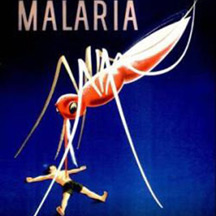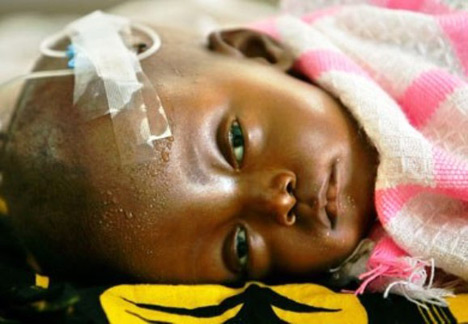|

Re-emergence of malaria: Lanka’s biggest challenge
By Carol Aloysius
 Malaria once feared as a disease that killed millions of people in
Sri Lanka in the mid 1930s, is now a disease of the past. The disease
which killed some 80,000 persons in the space of seven months during
1934-33, (setting up a record that surpassed deaths from all other
endemic diseases in this country including dengue) declined drastically
in the past decade. Malaria once feared as a disease that killed millions of people in
Sri Lanka in the mid 1930s, is now a disease of the past. The disease
which killed some 80,000 persons in the space of seven months during
1934-33, (setting up a record that surpassed deaths from all other
endemic diseases in this country including dengue) declined drastically
in the past decade.
The number of cases were reduced from 400,000 in 1994 to zero in
October 2012 ahead of the deadline set by the Mahinda Chintana policy
document to eliminate killer diseases in Sri Lanka.
This dramatic reduction in indigenous transmission of malaria is no
doubt a significant achievement for a tiny country such as Sri Lanka
with a limited health budget. But that does not mean that those who were
responsible for this achievement should now rest on their laurels. A
slight increase in the number of new cases of malaria in the country is
a warning signal that while indigenous transmission of malaria may have
come down to zero level, it can re-emerge in other ways - from imported
cases of travellers returning from malaria infested areas bringing the
disease in their bodies unaware of this fact.
“The fact that malaria is now highly prevalent in neighbouring
countries and the malaria vector is also abundant in Sri Lanka, means
that our biggest challenge today is the re-introduction of this disease
of the past, in possibly a more virulent form”, warns Anti Malaria
Campaign Director, Dr Risintha Premaratne.
He explains to the Sunday Observer how we can prevent this.
Excerpts…
Q. Malaria was once an endemic disease in this country.
Because it is now a disease of the past, not many people today know what
this disease is. Tell us, what is malaria? How is it caused?
A. Malaria is caused by a parasite called Plasmodium. The
parasites are spread to people through the bites of infected Anopheles
mosquitoes, called “malaria vectors”, which bite mainly at night. There
are four parasite species that cause malaria in humans:
• Plasmodium falciparum
• Plasmodium vivax
• Plasmodium malariae
• Plasmodium ovale.
Plasmodium falciparum and Plasmodium vivax are the most common
worldwide. Plasmodium falciparum is the most deadly.
In recent years, some human cases of malaria have also occurred with
Plasmodium knowlesi - a species that causes malaria among monkeys and
occurs in certain forested areas of South-East Asia.
In Sri Lanka, malaria was mainly due to Plasmodium vivax and
Plasmodium falciparum, vivax
Q. Of the diseases that vectors across the world transmit to
human beings, what is the commonest?
A. Malaria.
Q. Of these species what are the types that carry malaria
specifically?
|

A young victim |
A. Malaria is transmitted exclusively through the bites of
Anopheles mosquitoes. About 20 different Anopheles species are locally
important around the world. All of the important vector species bite at
night. Anopheles mosquitoes breed in water and each species has its own
breeding preference; for example some prefer shallow collections of
fresh water, such as puddles, rice fields, and hoof prints. Transmission
is more intense in places where the mosquito lifespan is longer (so that
the parasite has time to complete its development inside the mosquito)
and where it prefers to bite humans rather than other animals. For
example, the long lifespan and strong human-biting habit of the African
vector species is the main reason why about 90 percent of the world's
malaria deaths are in Africa.
Q. Do they also transmit other infectious diseases as well?
A . In Sri Lanka, No.
Q. Where is malaria most widely prevalent in Sri Lanka?
A. Malaria is endemic in 2/3s of Sri Lanka, in the dry zone
and the intermediate zones of the country (traditional malaria endemic
areas).
Q. Why are these areas so much at risk compared with others?
A. These areas have suitable temperature and humidity and
other ecological and environmental conditions ideal for breeding of the
main malaria vector mosquitoes in the country: the breeding sites are
abundant e.g river beds, sand pools, paddy fields, irrigation wells,
quarry pits, slow moving streams etc.
Q. Have scientific studies shown that the mosquito carrying
malaria is now mutating? If so, in what ways?
A. Mosquitoes have evolved over millions of years and they
continues to evolve. Malaria carrying mosquitoes have demonstrated how
rapidly they could get adapted to traditional vector control methods.
The evolution of insecticide resistance by Anopheles mosquito vectors
has severely hampered control efforts in the past (DDT was a global
success in 1950s but, resistance towards DDT and other insecticides
which were introduced thereafter is a classic example of their
adaptability through mutations). Although novel chemistries are being
explored, new insecticides will face similar problems with resistance
evolution. Similarly, there are other adaptations that are taking place
so that both the vector and the parasite would continue to survive to.
After all, it’s part of the evolution.
Q. In that case are the present techniques used to control the
mosquito and destroy its breeding sites or larvae adequate?
A. We need to be smarter than the enemy if we are to succeed.
This means, we need to closely monitor the changes that take place (in
the parasite, the vector and the other relevant factors) and come up
with strategies to respond accordingly. Ongoing research in the global
arena and locally are examples for such efforts.
There are newer / better anti malarial drugs and newer insecticides
formulated, drug and insecticide resistance development is monitored,
resistance containment strategies are being employed.
The success in malaria control globally and locally is as a result of
such adaptability of control programs for the changes that occur in the
vector and the parasite. The WHO and other organisations too played an
important role in our success in eliminating malaria.
Q. What are the techniques used to control the malaria
carrying vector?
A. Through entomological surveillance, the stages in the life
cycle of the vector is closely monitored within the country and action
is taken accordingly.
Most of these are ongoing programs.
Q. What are the present techniques now used?
A. The strategies used by the Anti Malaria Campaign for
elimination of malaria in Sri Lanka include the following.
* Early detection and prompt treatment of malaria cases and treatment
of asymptomatic parasite carriers.
Ensuring 100 percent case detection and confirmation by microscopy or
Rapid Diagnostic Tests (RDTs).
* Strengthening malaria surveillance system.
Notification and investigation of all cases to ensure radical cure
and prevention of secondary transmission.
* Planning and implementing selective and sustainable vector control
measures based on the principles of integrated vector management
* Forecasting and containment of malaria outbreaks/epidemics
* Provision of technical guidance, training of personnel and supply of
logistic items
* Partnership building and community involvement
*Monitoring and evaluation
*Research including operational research.
Ensure total indoor residual spraying coverage in and around each
malaria case and implement integrated strategies and techniques.
Q. What are the symptoms of malaria?
A. Malaria is an acute febrile illness. In a non-immune
individual, symptoms appear seven days or more (usually 10 -15 days)
after the infective mosquito bite. The first symptoms - fever, headache,
chills and vomiting - may be mild and difficult to recognize as malaria.
If not treated within 24 hours, P. falciparum malaria can progress to
severe illness often leading to death.
Children with severe malaria frequently develop one or more of the
following symptoms: severe anaemia, respiratory distress in relation to
metabolic acidosis, or cerebral malaria.
In adults, multi-organ involvement is also frequent. In malaria
endemic areas, persons may develop partial immunity, allowing
asymptomatic infections to occur. For both P. vivax and P. ovale ,
clinical relapses may occur weeks to months after the first infection,
even if the patient has left the malarious area. These new episodes
arise from dormant liver forms known as hypnozoites (absent in P.
falciparum and P. malariae); special treatment - targeted at these liver
stages - is required for a complete cure.
Q. How do you detect malaria early?
A. It can be detected by performing a simple blood test -
blood smear for malarial parasites - where just a drop of blood is
needed. In addition, there is a rapid diagnostic test available now
where a result can be given within 30 minutes.
Q. How does early detection help prevent the disease?
A. Early detection leading to prompt treatment will ensure
that the period of infectivity of the patient is shortened so that the
risk of transmission from the patient is reduced. In addition, early
detection will prevent patient from developing serious illness which may
lead to death.
Q. Are these tests available in all hospitals?
A. Yes. All hospitals have access to these tests which are
conducted free for patients in state hospitals.
Q. The DOTS method has been used successfully to control TB.
Do you have a similar method?
A. We directly observe patients while they are in hospital.
Q. What are the new main activities of your campaign?
A. Conducting awareness programs for the public and private
sector health staff on new goals of malaria elimination. Introducing in
service training for lab personnel engaged in malaria microscopy.
Q. Any new breakthroughs in treating patients?
A. Malaria parasite, especially Plasmodium falciparum is
notorious to develop resistance against commonly used anti malarial
drugs, which led to chloroquine resistant falciparum malaria and
subsequently several other drugs as well. Artemisinin based Combination
Therapy (ACT) has become the first-line treatment of uncomplicated
falciparum malaria in the recent times. However, Artemisinin resistance
is rapidly becoming an emerging issue in specific areas of the world.
Q. New studies?
A. Malaria is a subject which has been well researched and
continues to be subjected to advanced research in many technological
fronts. The scale of research done on malaria is such that there are
many peer reviewed international journals which are solely dedicated for
malaria related research.
Q. Your message to the public?
A. Sri Lanka has achieved a milestone victory by eliminating
malaria from the country. The last case of locally acquired malaria was
in October 2012. But, malaria can re-emerge in Sri Lanka to cause
immense suffering, disease and death, and impede social development as
the malaria mosquito is highly prevalent in the country and people
infected with malaria are entering the country.
My plea to the public is, keep Sri Lanka malaria-free: to doctors and
healthcare workers - be vigilant of malaria cases imported into the
country.
Diagnose and treat them early so that they do not transmit the
disease.
To foreign migrant workers and foreign travellers: - you may have
malaria. Please get yourself tested and treated immediately so as to
save your life as well as not to infect others.
To Sri Lankans travelling abroad - Please take malaria preventive
treatment before you leave. On your return to the country if you develop
fever within two months, alert your doctor.
Babies fed on breast milk less likely to die early in adulthood
Children who are not breastfed are more at risk of suffering from a
disease or dying early, a study has found.
Not receiving milk from their mother makes babies more likely to
suffer from chronic inflammation as adults, increasing their chances of
disease, disability and early death, it said.
On-going body-wide inflammation is also associated with low birth
weight, the same research showed. Chronic inflammation, caused by a
hyperactive immune system, has been linked to heart disease, strokes,
type-2 diabetes, late-life disability, and a greater risk of dying. The
condition is a natural response by the body’s immune system but
prolonged inflammation occurs when no infectious substances are present.
|

Exclusive breastfeeding should be done during the first six
months of a baby’s life. |
The new research found that adult levels of C-reactive protein (CRP),
an inflammation blood marker, rose with shorter durations of
breastfeeding in infancy.
Compared with receiving no mothers’ milk at all, being breastfed for
less than three months reduced CRP levels by a fifth. Breastfeeding for
three to six months lowered CRP levels by 26.7 per cent, six to 12
months by 29.6 percent, and more than 12 months by 29.8 percent.
The effect was at least the same as that produced by treatment with
cholesterol-lowering statin drugs.
Higher birth weight was also associated with lower CRP for
individuals who weighed more than 2.5kg. CRP was 9.2 percent greater for
those weighing in at 2.8kg than for those born a kilogram heavier.
The findings, come from a US study of almost 7,000 US men and women
aged 24 to 32. Less than half the participants (44.8 percent) were
breastfed for any length of time as infants.
Dr Thomas McDade, from Northwestern University and his team of
researchers wrote: “We present evidence that lower birth weight and
shorter durations of breastfeeding both predict elevated concentrations
of CRP in young adulthood, indicating increased risk for cardiovascular
and metabolic diseases that are major health burdens in the US and the
UK.
“Clinical trials have demonstrated that statin therapy reduces CRP in
healthy adults by 14.8 percent to 17.4 percent. Our results suggest that
the effects of breastfeeding on adult CRP are comparable, or larger, in
magnitude.”
The Department of Health recommends exclusive breastfeeding during
the first six months of a baby’s life.
Thereafter, mothers are encouraged to continue feeding with breast
milk alongside solid food into at least their baby’s second year.
Cost prevents breast cancer drug
A new drug for breast cancer which extends women’s lives by almost
six months is to be blocked from routine NHS access.
The National Institute for Health and Care Excellence said Kadcyla
can cost more than £90,000 per patient and is not effective enough to
justify the price.
The watchdog, which decides which new medicines are cost effective,
said its guidance for the drug was in draft form and is now up for
public consultation.
- PA
Families of children with autism benefit from dog ownership
Many families face the decision of whether to get a dog. For families
of children with autism, the decision can be even more challenging. Now,
a researcher has studied dog ownership decisions in families of children
with autism and found, regardless of whether they owned dogs, the
parents reported the benefits of dog ownership included companionship,
stress relief and opportunities for their children to learn
responsibility.
“Children with autism spectrum disorders often struggle with
interacting with others, which can make it difficult for them to form
friendships,” said Gretchen Carlisle, a research fellow at the Research
Center for Human - Animal Interaction (ReCHAI) in the MU College of
Veterinary Medicine. “Children with autism may especially benefit from
interacting with dogs, which can provide unconditional, non-judgemental
love and companionship to the children.”
 Carlisle interviewed 70 parents of children with autism. Nearly
two-thirds of the parents in the study owned dogs, and of those parents,
94 percent reported their children with autism were bonded to their
dogs. Even in families without dogs, 70 percent of parents said their
children with autism liked dogs. Many dog-owning parents said they
specifically chose to get dogs because of the perceived benefits to
their children with autism, Carlisle said. Carlisle interviewed 70 parents of children with autism. Nearly
two-thirds of the parents in the study owned dogs, and of those parents,
94 percent reported their children with autism were bonded to their
dogs. Even in families without dogs, 70 percent of parents said their
children with autism liked dogs. Many dog-owning parents said they
specifically chose to get dogs because of the perceived benefits to
their children with autism, Carlisle said.
“Dogs can help children with autism by acting as a social lubricant,”
Carlisle said. “For example, children with autism may find it difficult
to interact with other neighbourhood children. If the children with
autism invite their peers to play with their dogs, then the dogs can
serve as bridges that help the children with autism communicate with
their peers.”
Parents of children with autism should consider their children's
sensitivities carefully when choosing a dog in order to ensure a good
match between pet and child, he said.
“Bringing a dog into any family is a big step, but for families of
children with autism, getting a dog should be a decision that's taken
very seriously,” Carlisle said. “If a child with autism is sensitive to
loud noises, choosing a dog that is likely to bark will not provide the
best match for the child and the family. If the child has touch
sensitivities, perhaps a dog with a softer coat, such as a poodle, would
be better than a dog with a wiry or rough coat, such as a terrier.”
Carlisle recommends parents involve their children with autism when
choosing a dog.
“Many children with autism know the qualities they want in a dog,” he
said. “If parents could involve their kids in choosing dogs for their
families, it may be more likely the children will have positive
experiences with the animals when they are brought home.”
- MNT
|

